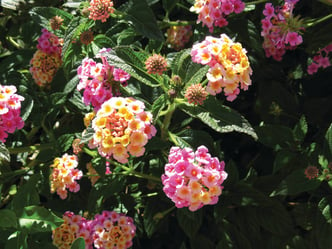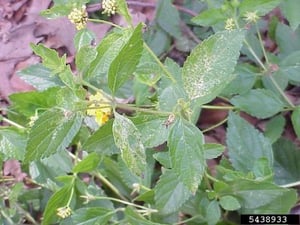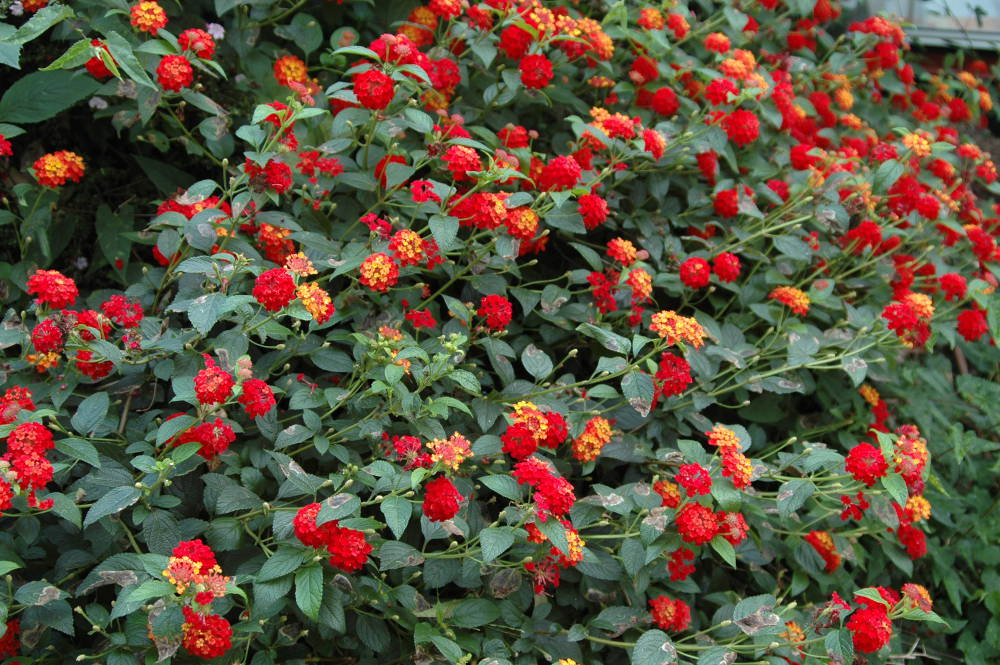As Lantana is so well established across the East Coast, prevention of spread is the most cost effective weed management tool, but what are the best methods? Read on below to learn better weed control methods.
Lantana is a shrub, introduced into Australia from Central & South America in 1841 and by the 1860s it was naturalised in the Sydney and Brisbane areas. Once grown as an ornamental, Lantana is now one of Australia’s most debilitating invasive weeds.
Lantana is recognised as a Weed of National Significance (WoNS) because of its impacts on primary industries, conservation and biodiversity, and the extent of its distribution.
Where is it?
Lantana currently infests more than four million hectares of land across Australia, mainly in areas east of the Great Dividing Range in NSW and Queensland. Its current range extends from the Bega Shire in southern NSW to Cape Melville in north Queensland.
What does it look like?
Lantana is a heavily-branched, scrambling, thicket-forming shrub, usually ranging from 2–4 m in height. Creeping lantana is a scrambling, low, woody shrub which often grows over rocks and along tree branches.

Flowers form in dense clusters and vary in colour from red–yellow, orange–pink, and white; depending on the type, maturity and location.
The fruit is a succulent, one-seeded drupe or berry about 6–8 mm in diameter. These develop in clusters and consist of aggregate, fleshy segments that are green at first and then turn a shiny, dark purple–black when ripe.
Lantana is a highly variable species with at least 29 varieties reportedly present as wild and cultivated species in Australia. There are five main types identified by flower colour: pink, red, orange, white and pink-edged red.
How does it spread?
Movement of water, contaminated soil and machinery, deliberate planting and poorly disposed garden waste can help lantana spread.
Fruit eating birds are the main cause of lantana spread. Birds and some mammals eat the fruit and the seed in their droppings is viable. Studies have shown that germination of lantana seed is more likely if the seed has travelled through the gut of a bird or mammal.
Life cycle
Germination can be year round but peaks after summer rains. Plants mature in one year, but they must complete one whole season before seeding. Vegetative spread can produce dense thickets.
In warm and humid areas lantana can flower and fruit almost year round, as long as soil moisture is available. A single plant can produce up to 12 000 fruit each year. Each fruit contains a single seed.
Lantana can survive in some drier areas and can even survive drought conditions by dropping its leaves. Dry lantana can appear to be dead but will reshoot from the base of the stem after rain. Frost affected lantana can also re-shoot after spring rains.

HOW Is Lantana a problem?
All forms of lantana are thought to be toxic, with the red-flowered forms being the most dangerous to stock. Lantana poisoning in cattle is quite common and causes major economic losses. During droughts or when other feed is scarce, stock are also more likely to graze lantana.
This slow and painful death is due mainly to liver insufficiency, kidney failure and, in some animals, myocardial damage and internal paralysis.
Lantana is also highly toxic to humans, and can cause serious illness and death. All parts of the plant, particularly the green berries, are poisonous if ingested, causing vomiting, diarrhoea, muscular weakness and respiratory distress. The plant is also a skin and eye irritant
Lantana is a problem, because it forms a dense thicket. Lantana is a lalopathic, releasing chemicals into the surrounding soil to prevent seed germination, notably of the native flora, so that it eventually takes over native bushland. It spreads quickly and can resist a range of climates.
MANAGE & CONTROL
 Prevention of lantana is vital to prevent the spread into un-infested ares.
Prevention of lantana is vital to prevent the spread into un-infested ares.
Herbicide control is highly effective and with a range of herbicides registered for lantana control, you should find it easy to find the best herbicide to suit your lantana infestation.
Below table goes over the list of registered high volume spray herbicides for lantana control using backpacks or sprayguns, however please double-check the registered rates in your state and follow all manufactures instructions for application. Listed herbicides registered at time of writing.
| ACTIVE CONSTITUENT | BRANDS | STATES |
| Glyphosate | 360g/L Roundup, Roudup Biactive, Weed Master Duo, Wipeout 360 | QLD, NSW, NT (restricted) |
| 540 g/L Roundup, PowerMAX | All states | |
| Picloram + Triclopyr | Grazon DS, Conqueror, Fightback | All states |
| Picloram + 2, 4-D amine | Tordon 75-D | QLD, NSW, WA, SA, VIC |
| Dichlorprop | Lantana 900 (previously DP 600) | QLD, NSW, NT |
| Fluroxypyr | Starane 200, Flagship 200, Comet 200 | QLD, NSW |
| 2, 4-D amine | 2,4-D Amine 625, Amicide | QLD, NSW, ACT, SA |
| Affray 300 | QLD | |
| Metsulfuron methyl | Brush-Off, Brushkiller 600, Lynx 600, Bushwacker WG, Metsulfuron 600 QG | QLD, NSW (some brands WA, ACT) |
| Cut-Out, Trounce Brush-pack | QLD, NSW, ACT | |
| Aminopyralid + fluroxypyr | Hotshot | All States |
With spraying, you will want to identify the best application of the herbicide; is it a large infestation that will require a larger, higher volume attack using a large spray unit or is it a small infestation that may only require a backpack sprayer?
Application of the herbicide on lantana is best done when it is actively or vigorously growing (flowering after rain is a good sign of this). Some herbicides will work best in other seasons than others, so it always best to check the product guidelines in relation to what season it works best in.
For best results, spray the lantana thoroughly on all foliage and stems to point of run-ff. Apply evenly to ensure the herbicide penetrates through the brush to hidden foliage with a recommended spraying pattern of side-by-side. To ensure complete coverage, also wet the soil around the base of the plant with herbicides to achieve best results. This will help with uptake through the root system and residual control of seedlings that may germinate.
Other best practice methods include ensuring clean water is used when mixing the herbicide and addition of a penetrate may improve results.
To achieve the best results, it is recommended to not spray stressed lantana (extreme weather, moisture stress such as drought, poor nutrition, presence of disease or heavy insect attack) as a reduced level of control may result costing more. Be aware of the weather; don't spray when rain is expected as it can wash away the herbicide and affect waterways, and ensure spraying starts after any expected annual flooding. Don't spray on windy days as this can cause overspray.
FOR EFFECTIVE AND FAST WEED CONTROL
THE SPRAYSCOUT
Our most nimble sprayer yet, the SprayScout has been designed to enable you to access those hard to reach locations. Made from highly durable yet lightweight materials, it can fit comfortably on the back of an UTV or dual cab ute, giving you the spray-power you want and the mobility you need.
LANTANA CONTROLLED?

The affects of spraying your lantana can take a few weeks to appear, with the death of the plant taking around 9-12 weeks. For some herbicides, death of the plant could take 3-6 months.
Signs of damage can include: brownout of leaves, defoliation, wilting, yellowing, dieback of the leaves.
REPORT LANTANA
If you need further help with controlling your lantana infestation, see below contacts.
| STATE | DEPARTMENT | PHONE | WEBSITE | |
| ACT | Environment NSW | 02 6207 9777 | environmentact@act.gov.au | www.environment.act.gov.au |
| NSW | NSW Agriculture | 1800 680 244 | weeds@agric.nsw.gov.au | www.agric.nsw.gov.au |
| NT | Dept. of Infrastructure, Planning and Environment | 08 8999 5511 | weedinfo.ipe@nt.gov.au | www.nt.gov.au |
| QLD | Dept. of Natural Resources and Mines | 07 3896 3111 | enquiries@nrm.qld.gov.au | www.nrm.qld.gov.au |
| SA | Dept. of Water, Land and Biodiversity Conservation | 08 8303 9500 | apc@saugov.sa.gov.au | www.dqlbc.sa.gov.au |
| VIC | Dept. of Primary Industries / Dept. of Sustainability and Environment | 136 186 | customer.service@dpi.vic.gov.au | www.dpi.vic.gov.au |
| WA | Dept. of Agriculture | 08 9368 3333 | enquiries@agric.wa.gov.au | www.agric.wa.gov.au |
| AUS wide | Australian Pesticides and Veterinary Medicines Authority | 02 6272 5852 | contact@apvma.gov.au | www.apvma.gov.au |




